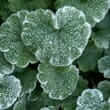Background
- Ground ivy belongs to the Lamiaceae family, which includes mints and herbs such as rosemary, pennyroyal, spearmint, basil, catnip, and thyme. Ground ivy is found in dams and shady places, especially in thickets, in Canada, most of the United States, the United Kingdom (except Scotland), Europe, northern Asia, and Japan.
- Traditionally, ground ivy has been used for tinnitus, catarrh, diarrhea, bile disorders, hemorrhoids, and as a tonic. Before hops were available in the early 16th Century, the British used ground ivy to clarify beer. During the Tudor period, it was used to preserve beer for sea voyages. Some old English recipes flavored jam with ground ivy and added young spring leaves to oatmeal, soups, and vegetables. In the early 20th Century, ground ivy tea was used in Britain as a cure-all, and was frequently used for tuberculosis and as an antidote for lead poisoning. The stems of the plant were also made into wreaths for the dead.
- Today, ground ivy is often a recommended addition to compost heaps because of its high iron content. Animal and laboratory studies indicate that ground ivy may be useful for its antibiotic or anti-inflammatory effects. However, ground ivy is considered by some local governments to be a bothersome and aggressive weed in Europe and North America. There are currently no high quality studies available on the medicinal applications of ground ivy.
References
Natural Standard developed the above evidence-based information based on a thorough systematic review of the available scientific articles. For comprehensive information about alternative and complementary therapies on the professional level, go to . Selected references are listed below.
- An HJ, Jeong HJ, Um JY, et al. Glechoma hederacea inhibits inflammatory mediator release in IFN-gamma and LPS-stimulated mouse peritoneal macrophages. J Ethnopharmacol 7-19-2006;106(3):418-424.
View Abstract - Henry DY, Gueritte-Voegelein F, Insel PA, et al. Isolation and characterization of 9-hydroxy-10-trans,12-cis-octadecadienoic acid, a novel regulator of platelet adenylate cyclase from Glechoma hederacea L. Labiatae. Eur J Biochem 12-30-1987;170(1-2):389-394.
View Abstract - Komprda T, Stohandlova M, Foltyn J, et al. Content of p-coumaric and ferulic acid in forbs with potential grazing utilization. Arch Tierernahr. 1999;52(1):95-105.
View Abstract - Kuhn H, Wiesner R, Alder L, et al. Occurrence of free and esterified lipoxygenase products in leaves of Glechoma hederacea L. and other Labiatae. Eur J Biochem 12-8-1989;186(1-2):155-162.
View Abstract - Kumarasamy Y, Cox PJ, Jaspars M, et al. Biological activity of Glechoma hederacea. Fitoterapia 2002;73(7-8):721-723.
View Abstract - Singh T, Wu JH, Peumans WJ, et al. Carbohydrate specificity of an insecticidal lectin isolated from the leaves of Glechoma hederacea (ground ivy) towards mammalian glycoconjugates. Biochem J 1-1-2006;393(Pt 1):331-341.
View Abstract - Tokuda H, Ohigashi H, Koshimizu K, et al. Inhibitory effects of ursolic and oleanolic acid on skin tumor promotion by 12-O-tetradecanoylphorbol-13-acetate. Cancer Lett 1986;33(3):279-285.
View Abstract - Wang W, Hause B, Peumans WJ, et al. The Tn antigen-specific lectin from ground ivy is an insecticidal protein with an unusual physiology. Plant Physiol 2003;132(3):1322-1334.
View Abstract - Wang W, Peumans WJ, Rouge P, et al. Leaves of the Lamiaceae species Glechoma hederacea (ground ivy) contain a lectin that is structurally and evolutionary related to the legume lectins. Plant J. 2003;33(2):293-304.
View Abstract - Zieba J. Isolation and identification of flavonoids from Glechoma hederacea L. Pol.J Pharmacol Pharm 1973;25(6):593-597.
View Abstract - Zieba J. Isolation and identification of non-heteroside triterpenoids from Glechoma hederacea L. Pol.J Pharmacol Pharm 1973;25(6):587-592.
View Abstract







